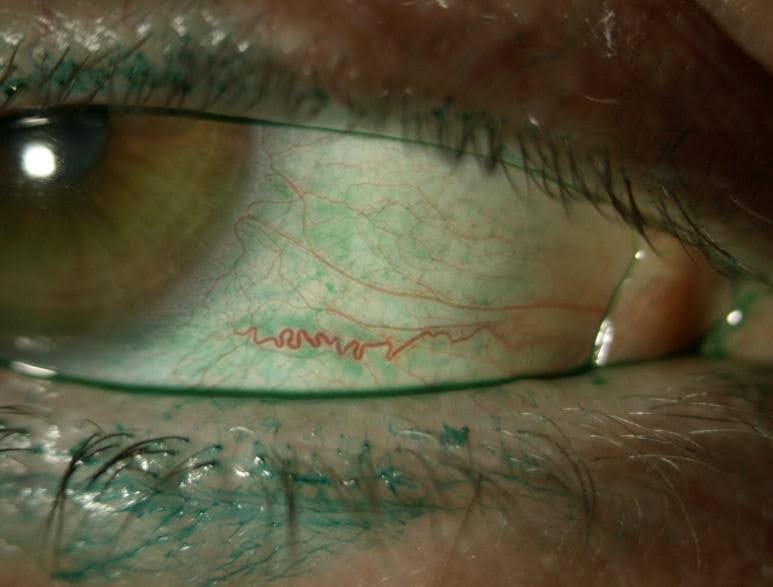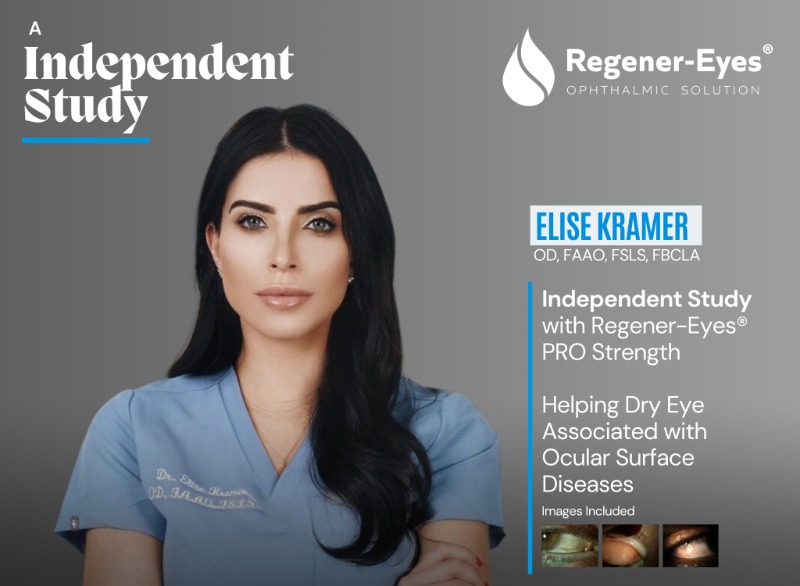Date: 4/24/2024
Please note that the independent studies showcased represent real patient outcomes submitted by healthcare professionals who have utilized Regener-Eyes. Regener-Eyes does not make any claims regarding the accuracy of this information.
Utilizing various tools at our disposal to manage ocular surface diseases, we, as optometrists, can customize treatments to apply to each patient’s specific needs. In my practice, I’ve found Regener-Eyes PRO to be particularly beneficial. I’m excited to share a case that reignited my enthusiasm for the comprehensive solutions we offer. After enduring years of persistent dry eye symptoms and discomfort, one of my patients finally experienced relief. This case report showcases the remarkable efficacy of Regener-Eyes PRO in addressing chronic dry eye issues.
Regener-Eyes PRO emerges as a revolutionary solution in addressing the widespread issue of dry eyes, offering a long-term approach that targets the root cause of discomfort. Backed by peer-reviewed research, Regener-Eyes stands out with its innovative technology targeting tear hyperosmolarity. This hypotonic solution restores balance, promotes eye health, and provides lasting relief by enhancing lubrication and hydration of the corneal surface.
With formulations customized for various severity levels and stringent quality standards ensuring safety, Regener-Eyes signifies hope for individuals seeking relief from dry eye symptoms. By prioritizing scientific research and compliance, Regener-Eyes sets a new standard in dry eye management, promising a future free from the constraints of this chronic condition.
Initial Visit:
A 49-year-old white female patient presented and reported severe pain and light sensitivity in both eyes. Referred by another eye care practitioner for a dry eye evaluation, she had previously been diagnosed with dry eye. She denied dry mouth and joint pain and had been using Ciprofloxacin QID OU with no improvement in symptoms. She had also used PredForte 1% QID in both eyes and Systane gel ointment every night, with only marginal improvement. Her presenting visual acuity with her current spectacles was 20/20 in each eye. An Ocular Surface Disease Index (OSDI) questionnaire revealed a score of 46- indicating severe symptoms.
During the slit lamp evaluation, the patient exhibited grade 4 Van Herrick angles bilaterally. Severe meibomian gland dropout was observed in the left eye compared to the right eye. Additionally, there was severe lissamine green staining of the conjunctiva and severe diffuse punctate staining of the cornea bilaterally. The anterior chamber appeared deep and quiet with no evidence of cell or flare. The iris and lens were clear, and the anterior vitreous was also clear bilaterally.
The patient was advised on several recommendations to manage her condition effectively. Firstly, she was educated on using warm compresses with eyelid hygiene twice daily, emphasizing the importance of integrating this into her daily routine to monitor symptom changes and maintain good hygiene practices.
Additionally, she has prescribed Optase tears for use as needed in both eyes and Retaine tears to be used twice daily in each eye. Oral Ω-3 capsules were recommended to supplement tear production. In-office treatments, including Tear Care and Blephex, were suggested to address ocular surface issues. Cequa 0.09% was prescribed twice daily in both eyes for further management. The patient was also advised to use Genteal gel once nightly in each eye for lubrication. Regener-Eyes PRO was recommended for use three times daily in both eyes to address dry eye symptoms effectively. Finally, considering the severity of her condition, scleral lenses were recommended as a potential long-term solution for improved ocular comfort and vision correction.
Follow-Up #1:
During the follow-up examination, the slit lamp findings remained consistent with the previous evaluation. The patient disclosed that she had discontinued using Regener-Eyes after completing the first bottle. As part of the updated recommendations, punctual plugs were suggested for today’s visit to address persistent dryness. Additionally, it was advised to restart using Regener-Eyes twice daily in both eyes and incorporate Siccasan overnight therapy for enhanced management of dry eye symptoms.
Follow-Up #2:
The patient reported significant relief in symptoms now that she was more consistent with the Regener-Eyes PRO. The treatment was continued, focusing on improving ocular surface stability.
Follow-Up #3:
During the patient’s latest visit, she reported continued use of Regener-Eyes and noted significant improvement in her symptoms. Her slit lamp examination revealed marked improvement compared to previous assessments. Given the enhanced stability of her ocular surface, the decision was made to fit her with daily disposable soft contact lenses.
Follow-Up #4:
Complete resolution of signs and symptoms was achieved after six months of Regener-Eyes PRO treatment.
Conclusion:
Regener-Eyes has played a vital role in stabilizing the patient’s ocular surface, providing swift relief without needing insurance approval. Its ability to create a stable ocular environment highlights the effectiveness of comprehensive treatment strategies in managing ocular surface diseases. While individual outcomes may differ, many patients have reported improved symptoms within 4-6 weeks of consistent Regener-Eyes use. Long-term usage may be necessary for optimal relief as Regener-Eyes targets the root cause of dryness. Supported by scientific research and FDA compliance, Regener-Eyes is the preferred choice for those seeking relief from dry eyes, offering hope and enhancing the quality of life for individuals coping with this chronic condition. As a pioneer in dry eye management, Regener-Eyes is reshaping lives and setting a new standard for relief.













